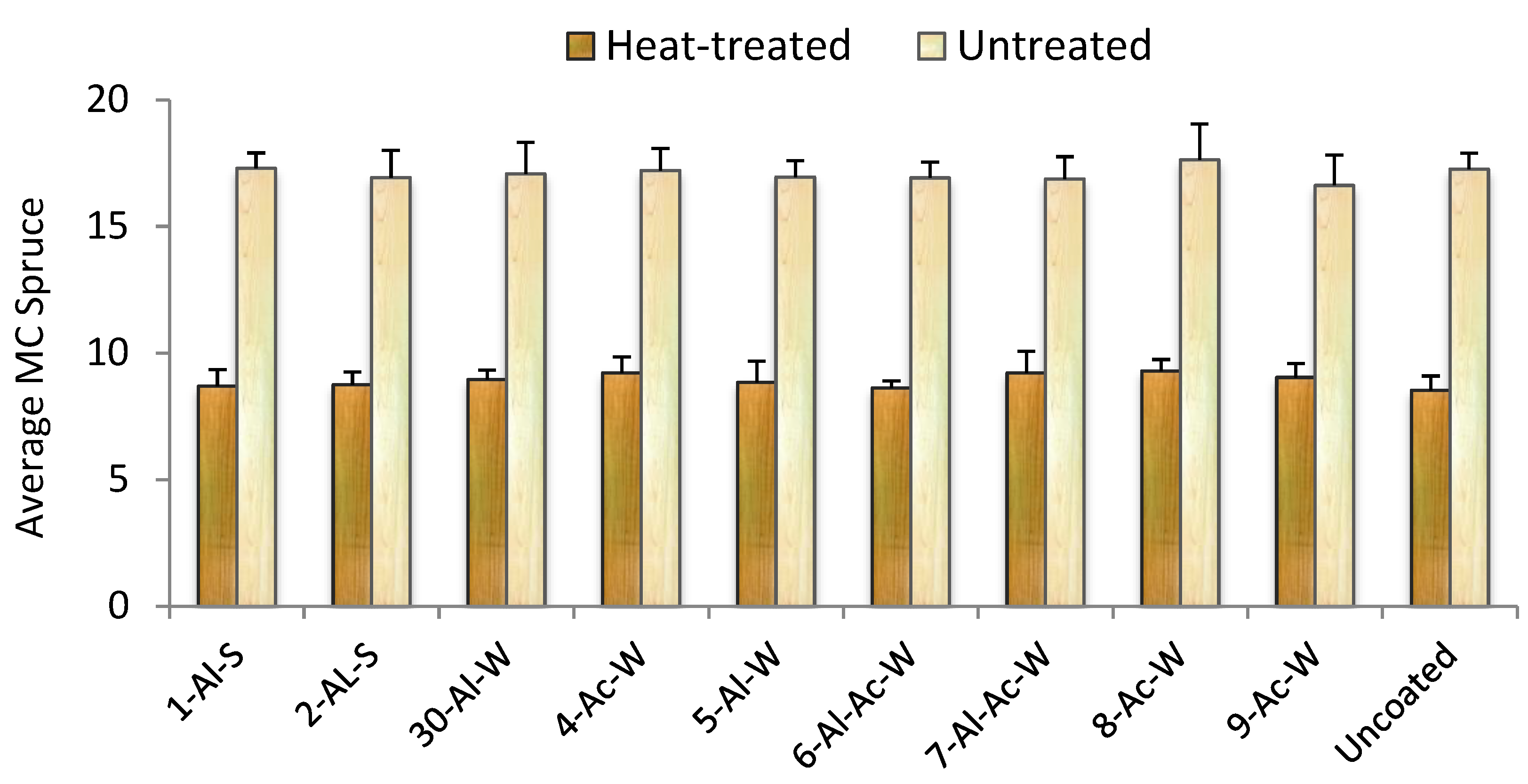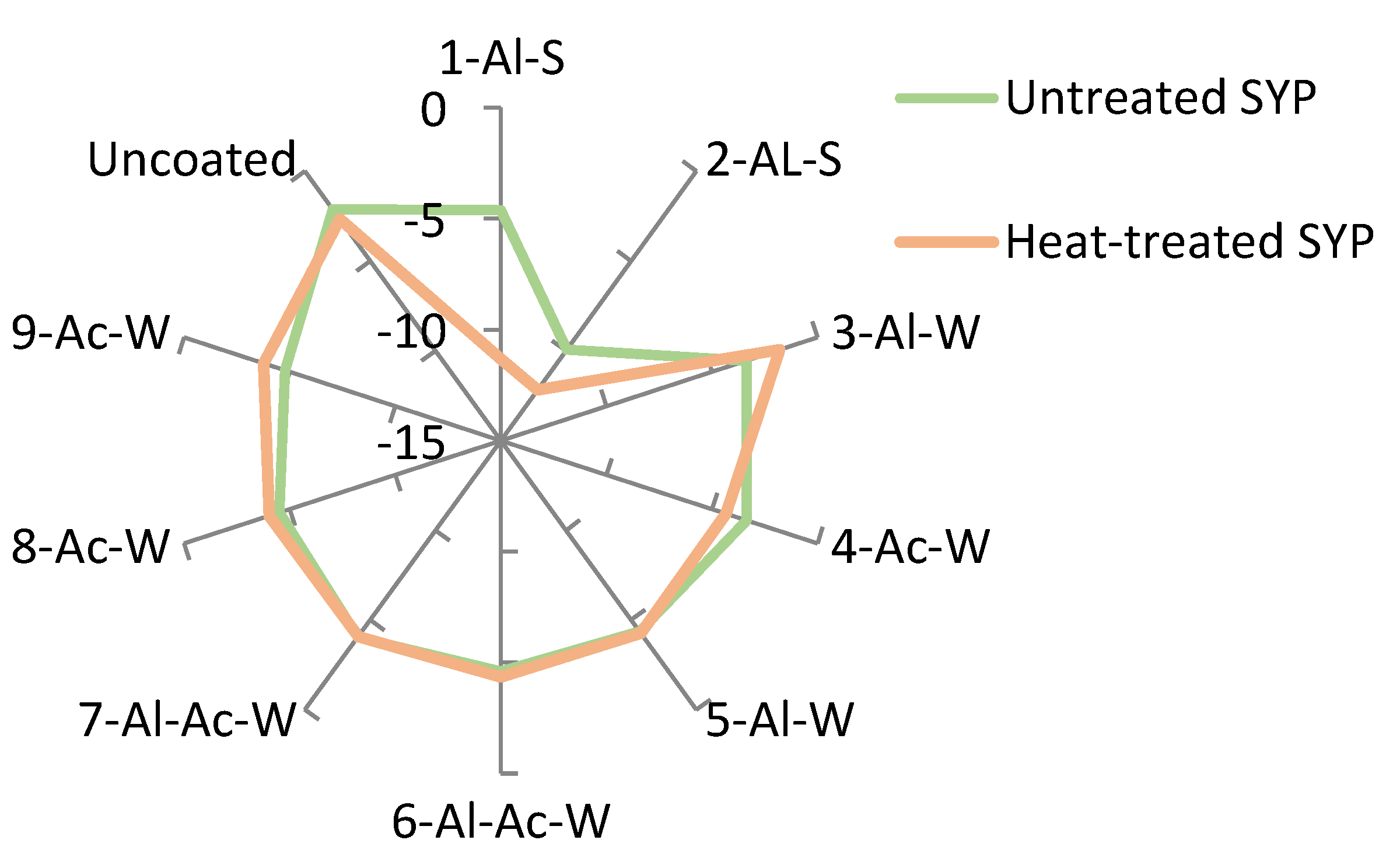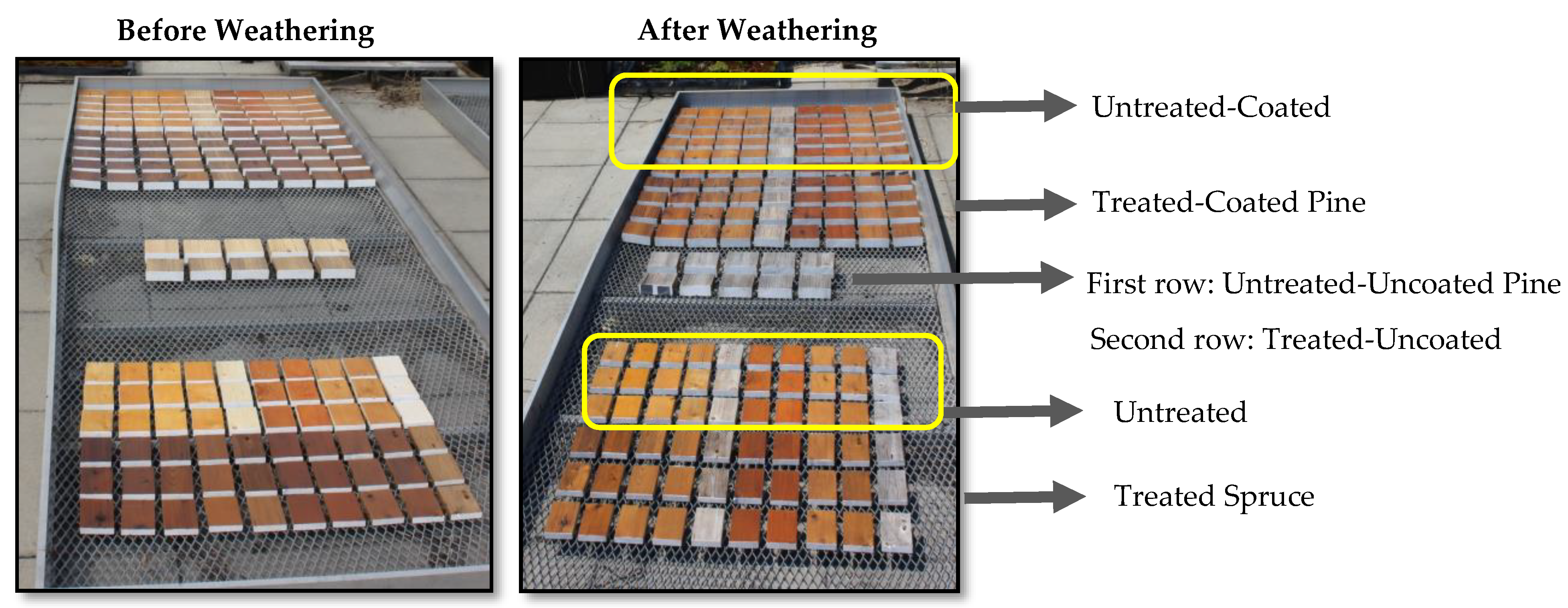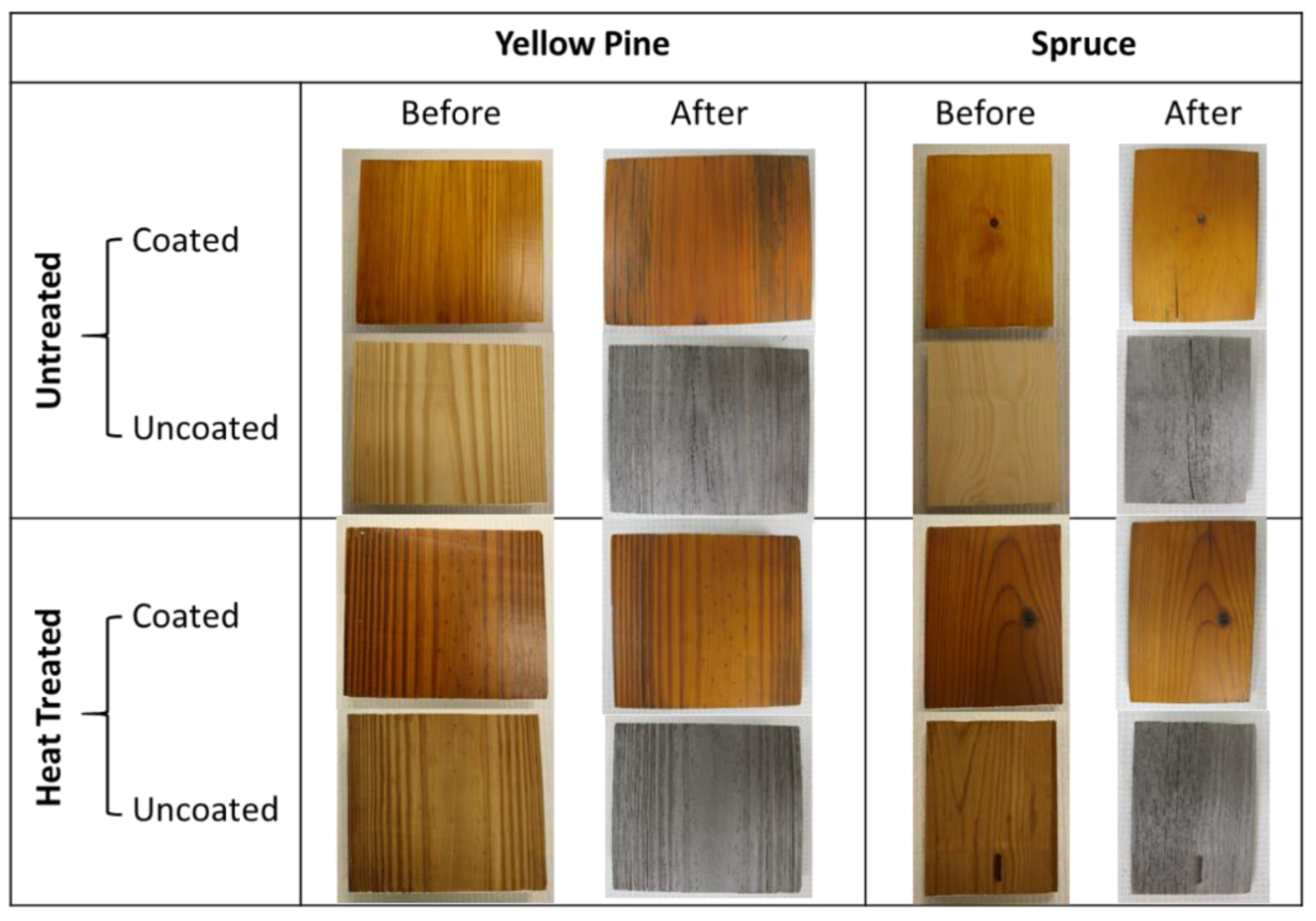Coating Performance on Exterior Oil-Heat Treated Wood
Abstract
:1. Introduction
2. Materials and Methods
3. Results and Discussion
3.1. Moisture Content
3.2. Color Change
3.3. Gloss Change
3.4. Appearance Ranking
4. Conclusions
Author Contributions
Funding
Acknowledgments
Conflicts of Interest
References
- Taylor, J.L. Effect of Exposure Conditions on Leaching of Chromated Copper Arsenate, CCA-C, from Treated Wood. Master’s Thesis, University of Toronto, Toronto, ON, Canada, September 2001. [Google Scholar]
- Temiz, A.; Yildiz, U.C.; Nilsson, T. Comparison of copper emission rates from wood treated with different preservatives to the environment. Build. Environ. 2006, 41, 910–914. [Google Scholar] [CrossRef]
- Flemming, C.A.; Trevors, J.T. Copper toxicity and chemistry in the environment: A review. Water. Air Soil Pollut. 1989, 44, 143–158. [Google Scholar] [CrossRef]
- Robinson, B.; Greven, M.; Green, S.; Sivakumaran, S.; Davidson, P.; Clothier, B. Leaching of copper, chromium and arsenic from treated vineyard posts in Marlborough, New Zealand. Sci. Total Environ. 2006, 364, 113–123. [Google Scholar] [CrossRef]
- Lebow, S. Leaching of Wood Preservative Components and Their Mobility in the Environment: Summary of Pertinent Literature. 1996; 36. [Google Scholar]
- Khan, B.I.; Jambeck, J.; Solo-Gabriele, H.M.; Townsend, T.G.; Cai, Y. Release of arsenic to the environment from CCA-treated wood. 2. Leaching and speciation during disposal. Environ. Sci. Technol. 2006, 40, 994–999. [Google Scholar] [CrossRef]
- Stook, K.; Tolaymat, T.; Ward, M.; Dubey, B.; Townsend, T.; Solo-Gabriele, H.; Bitton, G. Relative leaching and aquatic toxicity of pressure-treated wood products using batch leaching tests. Environ. Sci. Technol. 2005, 39, 155–163. [Google Scholar] [CrossRef] [PubMed]
- Sunda, W.G.; Tester, P.A.; Huntsman, S.A. Effects of cupric and zinc ion activities on the survival and reproduction of marine copepods. Mar. Biol. 1987, 94, 203–210. [Google Scholar] [CrossRef]
- Metsä-Kortelainen, S.; Paajanen, L.; Viitanen, H. Durability of thermally modified Norway spruce and Scots pine in above-ground conditions. Wood Mater. Sci. Eng. 2011, 6, 163–169. [Google Scholar] [CrossRef]
- Metsä-Kortelainen, S.; Viitanen, H. Effect of fungal exposure on the strength of thermally modified norway spruce and Scots pine. Wood Mater. Sci. Eng. 2010, 5, 13–23. [Google Scholar] [CrossRef]
- Esteves, B.M.; Pereira, H.M. Wood modification by heat treatment: A review. BioResources 2009, 4, 370–404. [Google Scholar]
- Awoyemi, L.; Cooper, P.A.; Ung, T.Y. In-treatment cooling during thermal modification of wood in soy oil medium: soy oil uptake, wettability, water uptake and swelling properties. Eur. J. Wood Wood Prod. 2009, 67, 465. [Google Scholar] [CrossRef]
- Dubey, K.M. Improvements in Stability, Durability and Mechanical Properties of Radiata Pine Wood after Heat-Treatment in a Vegetable Oil. Ph.D. Thesis, University of Canterbury, Christchurch, New Zealand, May 2010; pp. 1–211. [Google Scholar]
- Stamm, A.J.; Hansen, L.A. Minimizing wood shrinkage and swelling effect of heating in various gases. Ind. Eng. Chem. 1937, 29, 831–833. [Google Scholar] [CrossRef]
- Wikberg, H.; Maunu, S.L. Characterisation of thermally modified hard- And softwoods by 13C CPMAS NMR. Carbohydr. Polym. 2004, 58, 461–466. [Google Scholar] [CrossRef]
- Nuopponen, M.; Vuorinen, T.; Jámsä, S.; Viitaniemi, P. Thermal modifications in softwood studied by FT-IR and UV resonance Raman spectroscopies. J. Wood Chem. Technol. 2004, 24, 13–26. [Google Scholar] [CrossRef]
- Jämsä, S. Long-term natural weathering of coated ThermoWood. Pigment Resin Technol. 2000, 29, 68–74. [Google Scholar] [CrossRef]
- Kocaefe, D.; Saha, S. Comparison of the protection effectiveness of acrylic polyurethane coatings containing bark extracts on three heat-treated North American wood species: Surface degradation. Appl. Surf. Sci. 2012, 258, 5283–5290. [Google Scholar] [CrossRef]
- Esteves, B.M.; Domingos, I.J.; Pereira, H.M. Pine wood modification by heat treatment in air. BioResources 2008, 3, 1. [Google Scholar]
- Kesik, H.I.; Özkan, O.E.; Öncel, M. Characteristics of a protective layer on oil heat-treated scots pine and fir wood. BioResources 2017, 12, 3067–3075. [Google Scholar] [CrossRef]
- Wang, J.; Cooper, P. Review of Thermal Treatment of Wood. In Proceedings of the Canadian Wood Preservation Association, Halifax, NS, Canada, 28–29 October 2003; pp. 160–176. [Google Scholar]
- Rapp, A.O.; Sailer, M. Heat treatment of wood in Germany-state of the art. In Proceedings of the seminar on production of heat treated wood in Europe, Hamburg, Germany, 1–4 January 2000; Vol. 20, p. 2000. [Google Scholar]
- Altgen, M.; Militz, H. Thermally modified Scots pine and Norway spruce wood as substrate for coating systems. J. Coat. Technol. Res. 2017, 14, 531–541. [Google Scholar] [CrossRef]
- ASTM D2244. Standard Practice for Calculation of Color Tolerances and Color Differences from Instrumentally Measured Color Coordinates; UASTM International: West Conshochen, PA, USA, 2014. [Google Scholar]
- ASTM D660. Standard Test Method for Evaluating Degree of Checking of Exterior Paints; UASTM International: West Conshochen, PA, USA, 2011. [Google Scholar]
- ASTM D772. Test Method for Evaluating Degree of Flaking (Scaling) of Exterior Paints; UASTM International: West Conshochen, PA, USA, 2005. [Google Scholar]
- ASTM D3274. Test Method for Evaluating Degree of Surface Disfigurement of Paint Films by Fungal or Algal Growth, or Soil and Dirt Accumulation; UASTM International: West Conshochen, PA, USA, 2017. [Google Scholar]
- ASTM D662. Standard Test Method for Evaluating Degree of Erosion of Exterior Paints; UASTM International: West Conshochen, PA, USA, 2011. [Google Scholar]
- Bazyar, B. Decay resistance and physical properties of oil heat treated aspen wood. BioResources 2012, 7, 696–702. [Google Scholar]
- Rowell, R.M.; Ibach, R.E.; Nilsson, T. Wood durability and stability without toxicity. In Sustainable Development in the Forest Products Industry: Chapter 8; Universidade Fernando Pessoa: Porto, Portugal, 2010; pp. 181–208. ISBN 9789896430528. [Google Scholar]






| Coating ID | Resin | Base | Density | % Solid Content | Viscosity (mPa.s) | Number of Coats and Application | |
|---|---|---|---|---|---|---|---|
| 1-Al-S | Alkyd | Solvent | 0.87 | 40 ± 2 | 73 ± 1 | 1 | Only one coat |
| 2-Al-S | Alkyd | Solvent | 0.96 | 63 ± 2 | 1004 ± 10 | 2 | After 16 h |
| 3-Al-W | Alkyd | Water | 1.01 | 30 ± 2 | 882 ± 3 | 2 | After 20 min |
| 4-Ac-W | Acrylic | Water | 1.02 | 10 ± 0.0 | 21 ± 4 | 2 | Wet on wet |
| 5-Al-W | Alkyd | Water | 1.01 | 10 ± 0.1 | 213 ± 1 | 2 | Before 2 h |
| 6-Al-Ac-W | Alkyd- Acrylic | Water | 1.04 | 24 ± 0.1 | 24 ± 1 | 2 | After 24 h |
| 7-Al-Ac-W | Alkyd-Acrylic | Water | 1.03 | 24 ± 2 | 23 ± 1 | 2 | After 24 h |
| 8-Ac-W | Acrylic | Water | 1.05 | 25 ± 2 | 352 ± 4 | 2 | After 24 h |
| 9-Ac-W | Acrylic | Water | 1.03 | 23 ± 1 | 59 ± 2 | 2 | After 24 h |
| Paint | Untreated Spruce | Heat−Treated Spruce | ||||||
|---|---|---|---|---|---|---|---|---|
| Color | ∆L | ∆a | ∆b | ∆E | ∆L | ∆a | ∆b | ∆E |
| 1−Al−S | −37 ± 2 | −32 ± 3 | −41 ± 3 | 64 ± 1 | 6 ± 2 | −35 ± 1 | −8 ± 2 | 36 ± 1 |
| 2−Al−S | −29 ± 4 | −31 ± 1 | −43 ± 6 | 61 ± 5 | −3 ± 6 | −27 ± 1 | −4 ± 2 | 28 ± 2 |
| 3−Al−W | −44 ± 3 | −33 ± 3 | −46 ± 3 | 72 ± 2 | −3 ± 3 | −34 ± 1 | −12 ± 1 | 36 ± 1 |
| 4−Ac−W | −39 ± 3 | −32 ± 4 | −46 ± 2 | 68 ± 1 | −12 ± 2 | −31 ± 1 | −17 ± 5 | 38 ± 4 |
| 5−Al−W | −49 ± 2 | −30 ± 1 | −38 ± 2 | 69 ± 2 | −7 ± 3 | −35 ± 5 | −37 ± 4 | 52 ± 6 |
| 6−Al−Ac−W | −28 ± 5 | −33 ± 1 | −43 ± 2 | 61 ± 3 | −9 ± 1 | −24 ± 1 | −10 ± 1 | 28 ± 1 |
| 7−Al−Ac−W | −31 ± 3 | −35 ± 1 | −42 ± 3 | 62 ± 3 | −9 ± 2 | −24 ± 2 | −11 ± 4 | 28 ± 4 |
| 8−Ac−W | −30 ± 1 | −31 ± 1 | −33 ± 1 | 54 ± 1 | −5 ± 2 | −26 ± 2 | −6 ± 3 | 28 ± 2 |
| 9−Ac−W | −29 ± 2 | −29 ± 1 | −32 ± 1 | 52 ± 1 | −6 ± 2 | −27 ± 2 | −5 ± 3 | 28 ± 3 |
| Uncoated | −52 ± 1 | −29 ± 1 | −30 ± 1 | 67 ± 1 | −22 ± 3 | −34 ± 1 | −39 ± 1 | 57 ± 1 |
| Tukey Grouping | Mean | N | Coating | |
|---|---|---|---|---|
| – | A | 63.8 | 16 | 5 |
| – | A | 63.4 | 16 | Uncoated |
| B | A | 57.1 | 16 | 3 |
| B | – | 55.5 | 16 | 4 |
| B | C | 51.6 | 16 | 1 |
| D | C | 47.0 | 16 | 7 |
| D | C | 46.8 | 16 | 2 |
| D | C | 45.5 | 16 | 6 |
| D | – | 42.3 | 16 | 9 |
| D | – | 42.9 | 16 | 8 |
| Treatment | Coatings | Southern Pine | Spruce | ||||||
|---|---|---|---|---|---|---|---|---|---|
| Checking | Mildew | Erosion | General | Checking | Mildew | Erosion | General | ||
| Untreated | 1-Al-S | 4 ± 1 | 4 ± 1 | 3 ± 1 | 3 ± 1 | 7 ± 1 | 7 ± 2 | 2 ± 0 | 3 ± 1 |
| 2-Al-S | 7 ± 2 | 6 ± 1 | 6 ± 1 | 6 ± 2 | 9 ± 1 | 9 ± 1 | 9 ± 1 | 8 ± 2 | |
| 3-Al-W | 5 ± 1 | 3 ± 1 | 2 ± 1 | 2 ± 0 | 7 ± 3 | 4 ± 0 | 3 ± 1 | 2 ± 0 | |
| 4-Ac-W | 4 ± 0 | 7 ± 4 | 0 ± 0 | 1 ± 2 | 5 ± 3 | 10 ± 0 | 0 ± 0 | 1 ± 1 | |
| 5-Al-W | 4 ± 1 | 5 ± 5 | 0 ± 0 | 1 ± 1 | 7 ± 4 | 10 ± 0 | 1 ± 1 | 2 ± 2 | |
| 6-Al-Ac-W | 8 ± 1 | 7 ± 3 | 6 ± 2 | 6 ± 2 | 6 ± 4 | 7 ± 1 | 4 ± 0 | 3 ± 1 | |
| 7-Al-Ac-W | 6 ± 2 | 7 ± 1 | 6 ± 1 | 6 ± 0 | 7 ± 3 | 8 ± 2 | 6 ± 0 | 5 ± 2 | |
| 8-Ac-W | 6 ± 2 | 6 ± 2 | 4 ± 1 | 5 ± 1 | 7 ± 2 | 9 ± 1 | 7 ± 1 | 5 ± 1 | |
| 9-Ac-W | 7 ± 1 | 6 ± 1 | 6 ± 1 | 6 ± 1 | 9 ± 1 | 9 ± 1 | 7 ± 1 | 6 ± 2 | |
| Uncoated | 5 ± 2 | 8 ± 2 | 0 ± 0 | 5 ± 1 | 7 ± 3 | 10 ± 0 | 0 ± 0 | 5 ± 2 | |
| Heat-treated | 1-Al-S | 7 ± 1 | 5 ± 2 | 4 ± 1 | 4 ± 1 | 9 ± 1 | 8 ± 0 | 2 ± 0 | 2 ± 0 |
| 2-Al-S | 7 ± 1 | 9 ± 1 | 7 ± 1 | 7 ± 1 | 9 ± 1 | 10 ± 0 | 10 ± 0 | 8 ± 0 | |
| 3-Al-W | 5 ± 11 | 2 ± 1 | 1 ± 1 | 1 ± 1 | 7 ± 4 | 5 ± 1 | 5 ± 1 | 2 ± 0 | |
| 4-Ac-W | 5 ± 1 | 9 ± 1 | 0 ± 0 | 1 ± 1 | 6 ± 3 | 0 ± 0 | 0 ± 0 | 2 ± 0 | |
| 5-Al-W | 6 ± 1 | 9 ± 1 | 0 ± 0 | 1 ± 1 | 7 ± 4 | 0 ± 0 | 0 ± 0 | 2 ± 0 | |
| 6-Al-Ac-W | 7 ± 1 | 8 ± 1 | 6 ± 1 | 6 ± 1 | 9 ± 1 | 9 ± 1 | 8 ± 0 | 7 ± 1 | |
| 7-Al-Ac-W | 7 ± 1 | 8 ± 0 | 6 ± 0 | 6 ± 1 | 10 ± 0 | 8 ± 0 | 7 ± 1 | 7 ± 1 | |
| 8-Ac-W | 7 ± 2 | 8 ± 1 | 6 ± 1 | 6 ± 1 | 7 ± 4 | 7 ± 1 | 8 ± 0 | 6 ± 0 | |
| 9-Ac-W | 7 ± 2 | 8 ± 1 | 7 ± 1 | 6 ± 2 | 8 ± 3 | 8 ± 0 | 8 ± 0 | 7 ± 1 | |
| Uncoated | 4 ± 1 | 9 ± 1 | 0 ± 0 | 5 ± 1 | 7 ± 4 | 0 ± 0 | 0 ± 0 | 2 ± 0 | |
| Tukey Grouping | Mean | N | Coating | Base |
|---|---|---|---|---|
| A | 7.5 | 15 | 2 | Solvent |
| 7.1 | 15 | 9 | Water | |
| A | 6.7 | 15 | 7 | Water |
| A | 6.6 | 15 | 6 | Water |
| A | 6.4 | 15 | 8 | Water |
| B | 4.4 | 15 | 1 | Solvent |
| B | 4.4 | 15 | Uncoated | --- |
| B | 3.4 | 15 | 5 | Water |
| B | 3.3 | 15 | 4 | Water |
| 3.1 | 15 | 3 | Water |
© 2019 by the authors. Licensee MDPI, Basel, Switzerland. This article is an open access article distributed under the terms and conditions of the Creative Commons Attribution (CC BY) license (http://creativecommons.org/licenses/by/4.0/).
Share and Cite
Nejad, M.; Dadbin, M.; Cooper, P. Coating Performance on Exterior Oil-Heat Treated Wood. Coatings 2019, 9, 225. https://doi.org/10.3390/coatings9040225
Nejad M, Dadbin M, Cooper P. Coating Performance on Exterior Oil-Heat Treated Wood. Coatings. 2019; 9(4):225. https://doi.org/10.3390/coatings9040225
Chicago/Turabian StyleNejad, Mojgan, Mahdi Dadbin, and Paul Cooper. 2019. "Coating Performance on Exterior Oil-Heat Treated Wood" Coatings 9, no. 4: 225. https://doi.org/10.3390/coatings9040225
APA StyleNejad, M., Dadbin, M., & Cooper, P. (2019). Coating Performance on Exterior Oil-Heat Treated Wood. Coatings, 9(4), 225. https://doi.org/10.3390/coatings9040225





